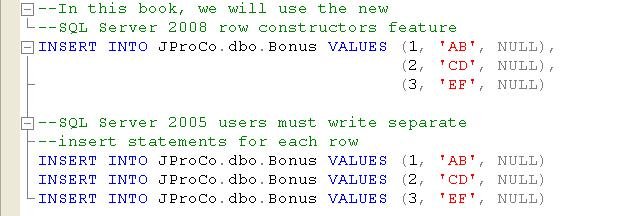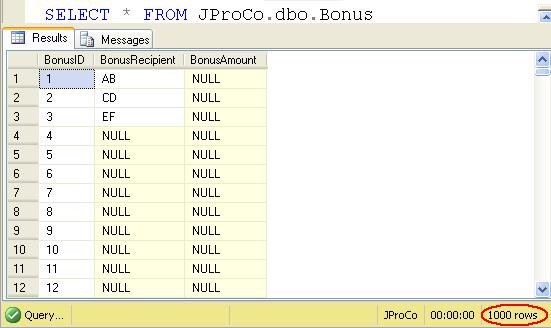Answer simple quiz at the end of the blog post and –
Every day one winner from India will get Joes 2 Pros Volume 3.
Every day one winner from United States will get Joes 2 Pros Volume 3.
Sparse Data
Fields with fixed length data types (e.g., int, money) always consume their allotted space irrespective of how much data the field actually contains. This is true even if the field is populated with a null.
Occasionally you will encounter a column in your database which is rarely used. For example, suppose you have a field called [Violation] in a table called [Employee] but very few employees have any violations – perhaps two or three for every 1000 employees. In this case, over 99% of the Violation field values are null. This would be an example of a sparsely populated field.
To demonstrate a sparsely populated field, we will create a simple table with the design shown here. Create and populate the dbo.Bonus table by running this code in the figures below.


Please note that INSERT statements demonstrated will use row constructors, which debuted as a new feature in SQL Server 2008. However, readers who are running SQL Server 2005 must write their INSERT statements using the alternate syntax shown in the lower portion of the last Figure.
Now look at all the records in the table. Since all fields contain fixed length data types (i.e., int, char(2), money), we could have accurately calculated the per row consumption before we even added any data to the table.

Each row of the Bonus table will consume 21 bytes based on the data below.
- Row Header – 4 bytes (true for all rows).
- Fixed Data – 14 bytes (BonusID is an int (4 bytes) and BonusAmount’s data type is money (8 bytes).
- Null Block (aka Null Bitmap) – 3 bytes
The nulls in the money field do not change the space consumption because fixed length data types always use the full amount of space allocated to them. At 21 bytes per row, 1000 rows of the Bonus table would require 21,000 bytes and fill up about 3 data pages (1 data page = 8060 bytes). Currently there are only three records in this table so just 1 data page of 8K has started to fill up.
Analyzing Space Used
A handy tool for checking the storage amount which an object occupies is sp_spaceused. The figure below shows the Bonus table passed into this stored procedure. We see the Bonus table contains three rows and its data has not yet exceeded its first 8 KB page.

If you added enough records the data space used would need more memory pages. Let’s run a loop to add 997 more records to the Bonus table. The first record populated will be row 4. This loop increments each subsequent BonusID value by 1, and the loop runs as long as the BonusID value is <=1000. Once the row containing BonusID 1000 has been entered into the table, the loop will end. One run the Bonus table contains 1000 records.


Since one row occupies 21 bytes, we know these 1000 rows will take up 21 KB of space and should fit within three data pages.
[21000 bytes/(8060 bytes/page) = 2.61 pages]
Since you can use half a data page SQL dedicated 3 data pages to the Bonus table. Let’s rerun the sp_spaceused sproc and confirm the number of data pages.

Using the Sparse Data Option
The sparse data option is a new SQL Server 2008 feature for fields you expect to be predominantly null. Using the sparse data option, you can instruct SQL Server to not have nulls consume space in sparsely populated fields.
To test this we’re going to delete the Bonus table and then re-create it using the same steps we took previously. The only difference will be that the BonusAmount field will be created using the sparse option. Recall we expect the BonusAmount field to contain very little actual data – most records will be null.

Recall we expect the BonusAmount field to contain very little actual data – most records will be null. The Bonus table now contains 1000 records and BonusAmount is a sparse field, but so far we don’t see any difference in the appearance of the table or the data.

Now let’s review how much space the Bonus table is consuming. Let’s confirm the space usage is less in this example. Had you not used the sparse option the consumption would have been 24KB like in our last example.

Note: If you want to setup the sample JProCo database on your system you can watch this video. For this post you will want to run the SQLArchChapter4.0Setup.sql script from Volume 3.
Question 17
You have two fields, of INT and MONEY, in your Bonus table. You have 1000 records and all instances of the money column are null. When you set up the money field, you used the Sparse option. How much space are the 1000 rows of the money field using?
- None
- 4000 bytes
- 8000 bytes
Do not forget to participate in special question over here: Pluralsight Giving Away Free Subscription to Quiz Participants
Rules:
Please leave your answer in comment section below with correct option, explanation and your country of resident.
Every day one winner will be announced from United States.
Every day one winner will be announced from India.
A valid answer must contain country of residence of answerer.
Please check my facebook page for winners name and correct answer.
Winner from United States will get Joes 2 Pros Volume 3.
Winner from India will get Joes 2 Pros Volume 3.
The contest is open till next blog post shows up at which is next day GTM+2.5.
Reference: Pinal Dave (https://blog.sqlauthority.com)






96 Comments. Leave new
You have two fields, of INT and MONEY, in your Bonus table. You have 1000 records and all instances of the money column are null. When you set up the money field, you used the Sparse option. How much space are the 1000 rows of the money field using?
None
4000 bytes
8000 bytes
Solution :
The correct answer is None. When the money column is created with sparse option and all the 1000 rows are Null then no space is used. This is the property of sparse columns.
The second and third options are wrong as they indicate some space occupied which doesn’t apply for sparse columns with all Null values.
Nagaraj Ejanthkar
USA
choice #1 is correct, no space is being used for sparse money data type fields with null value. 0 x 1000 = 0
Chris Lennick
United States
option 1 is correct
because money field is null so it will take no space and you have asked only space used by money field
tej narayan maurya
new delhi, india
none that is option one is correct
because money field is null so it will take no space and you have asked only space used by money field
tej narayan maurya
new delhi, india
Option 3 is the answer as
Integer and header occupies 8bytes and money column is specified as sparse so for 1000 records it will be 8000 bytes
Option 3 is the answer as
Integer and header occupies 8bytes and money column is specified as sparse so for 1000 records it will be 8000 bytes
Purna Magum
India
Correct Ans is Option 1
1. None
Pratik Raval
India
Option 3 8000 bytes is correct.
Rahul Sharma
Noida India
Correct Answer Option #1
SPARSE Column consumes NO SPACE for NULL values.
Cochin,INDIA
correct answer is option #1
i.e: none
money column is specified with sparse..
Azaad mohammed
mumbai,india
Correct Answer is Option 1.
1.None
Country:India
Thanks,
Fazal Vahora
Correct Answer is : Option 1) None
— GVPrabu || Bangalore || India
Correct Ans is 2
2.) 4000 bytes
Reson There is 1000 rows and Every row has a 4 byte header because we are using sparse so sparse column datatype size will be not added here
Abhishek Mishra
INDIA, NOIDA
Correct Option is 1.
Shilpa
India
correct option is
1. None
City: Baroda
Country: India
Thanks
GurjitSingh
The Correct Answer is : #3
Mohd Thoufeek
chennai – india
option 1.
if all value for the money column is null then it will not take any space. as the column is defined as sparse.
ghanshyam
bangalore
The Correct answer is
1.None
Correct option is #1. Money field created with the keyword Sparse and having Null values won’t be using any space.
Correct Option is 1> None
INDIA